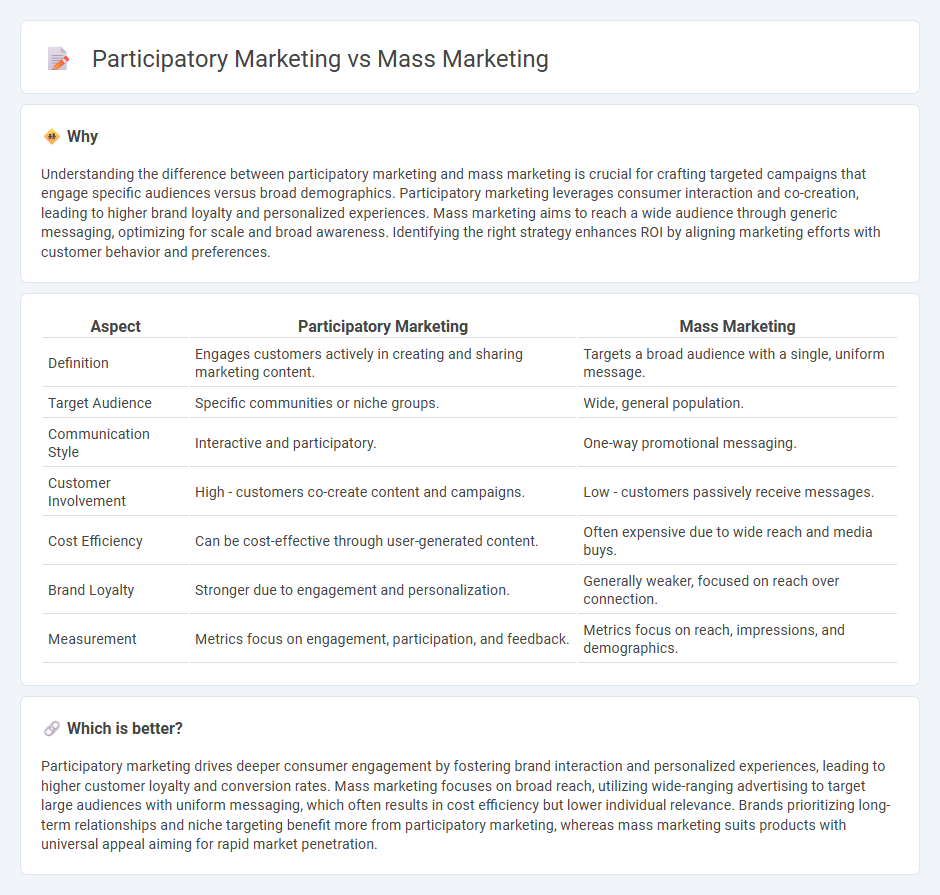
Participatory marketing engages consumers directly by encouraging interaction, feedback, and collaboration, fostering brand loyalty and personalized experiences. Mass marketing targets a broad audience with a uniform message, aiming for maximum reach and brand awareness through traditional media channels. Explore the strategic benefits and applications of participatory versus mass marketing to enhance your campaign effectiveness.
Why it is important
Understanding the difference between participatory marketing and mass marketing is crucial for crafting targeted campaigns that engage specific audiences versus broad demographics. Participatory marketing leverages consumer interaction and co-creation, leading to higher brand loyalty and personalized experiences. Mass marketing aims to reach a wide audience through generic messaging, optimizing for scale and broad awareness. Identifying the right strategy enhances ROI by aligning marketing efforts with customer behavior and preferences.
Comparison Table
| Aspect | Participatory Marketing | Mass Marketing |
|---|---|---|
| Definition | Engages customers actively in creating and sharing marketing content. | Targets a broad audience with a single, uniform message. |
| Target Audience | Specific communities or niche groups. | Wide, general population. |
| Communication Style | Interactive and participatory. | One-way promotional messaging. |
| Customer Involvement | High - customers co-create content and campaigns. | Low - customers passively receive messages. |
| Cost Efficiency | Can be cost-effective through user-generated content. | Often expensive due to wide reach and media buys. |
| Brand Loyalty | Stronger due to engagement and personalization. | Generally weaker, focused on reach over connection. |
| Measurement | Metrics focus on engagement, participation, and feedback. | Metrics focus on reach, impressions, and demographics. |
Which is better?
Participatory marketing drives deeper consumer engagement by fostering brand interaction and personalized experiences, leading to higher customer loyalty and conversion rates. Mass marketing focuses on broad reach, utilizing wide-ranging advertising to target large audiences with uniform messaging, which often results in cost efficiency but lower individual relevance. Brands prioritizing long-term relationships and niche targeting benefit more from participatory marketing, whereas mass marketing suits products with universal appeal aiming for rapid market penetration.
Connection
Participatory marketing engages consumers directly, fostering brand loyalty and personalized experiences, while mass marketing targets broad audiences with generalized messages. Both strategies aim to maximize market reach and influence consumer behavior, with participatory marketing enhancing mass marketing's effectiveness through consumer involvement. Integrating participatory marketing principles into mass marketing campaigns can drive higher engagement and conversion rates by appealing to individual customer preferences within large-scale promotions.
Key Terms
Audience Segmentation
Mass marketing targets a broad audience without customization, relying on generalized messages to reach the largest possible market segment efficiently. Participatory marketing emphasizes in-depth audience segmentation, engaging specific groups by tailoring content and encouraging active consumer involvement to boost relevance and loyalty. Explore the nuances of audience segmentation strategies to enhance your marketing effectiveness.
Customer Engagement
Mass marketing targets broad audiences through generalized messaging to maximize reach and brand awareness, often resulting in low individual customer engagement. Participatory marketing emphasizes active customer involvement, fostering deeper connections through personalized interactions and co-creation of content, significantly enhancing engagement and brand loyalty. Explore strategies to elevate your customer engagement by understanding the shift from mass to participatory marketing.
Personalization
Mass marketing targets broad audiences with uniform messages, prioritizing volume over individual preferences. Participatory marketing emphasizes personalization by engaging consumers directly, leveraging user-generated content and real-time feedback to tailor experiences. Explore more insights into how personalization transforms marketing strategies and consumer engagement.
Source and External Links
What is Mass Marketing? | A definition - Mass marketing is a strategy aimed at reaching large populations through mass media outlets by broadcasting one-size-fits-all promotional messages to a broad and undifferentiated audience, using channels like TV, radio, and print ads.
What Is Mass Marketing? How It Works and Why It Matters - Mass marketing promotes products to a large audience without market segmentation, using broad channels such as television and newspapers to deliver a unified message that maximizes exposure and sales volume.
6 Mass Marketing Strategies To Implement (With Tips) - Mass marketing involves promoting products or services broadly rather than to targeted groups, often employing traditional and digital media to maximize brand awareness and sales for widely used products like toothpaste or automobiles.
 dowidth.com
dowidth.com